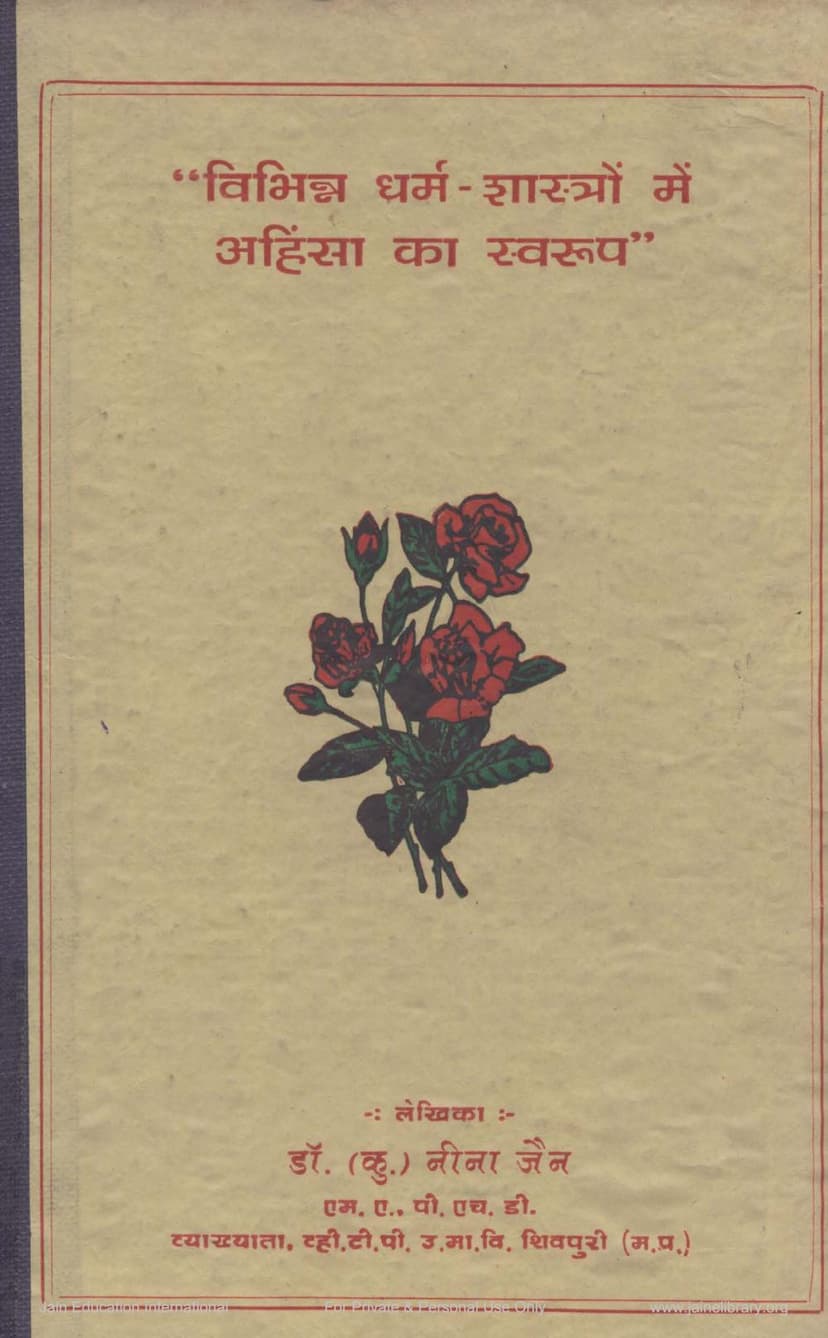Vibhinna Dharm Shastro Me Ahimsa Ka Swarup
Added to library: September 2, 2025

Summary
Here's a comprehensive summary of the Jain text "Vibhinna Dharm Shastro me Ahimsa ka Swarup" by Dr. Nina Jain, based on the provided pages:
The book, "Vibhinna Dharm Shastro me Ahimsa ka Swarup" (The Nature of Ahimsa in Various Religious Scriptures), authored by Dr. Nina Jain and published by Shri Kashinath Saraf Shivpuri, delves into the concept of Ahimsa (non-violence) across different religious traditions.
Author and Publisher:
- Author: Dr. Nina Jain (Lecturer, V.T.P. Higher Secondary School, Shivpuri, Madhya Pradesh).
- Publisher: Shri Kashinath Saraf Acharya Shri Vijayendrasuri Shodh Sansthan, Shivpuri, Madhya Pradesh.
- Publication Details: First Edition, published in Vikram Samvat 2051 / Veer Samvat 2520 / 1995 AD.
Core Theme: The central theme of the book is to explore and present the concept of Ahimsa as understood and advocated in the scriptures of various religions. Dr. Jain's primary motivation for writing this book stems from the current societal trends where, in her view, there's a declining adherence to Ahimsa among the general populace and even the ruling class. She notes the proliferation of slaughterhouses and argues against the justification often given for them (problems with stray cattle), drawing a parallel to the potential rejection of elderly parents if such logic were applied.
Structure and Content Overview: The book is structured to analyze Ahimsa in a comparative religious context. The detailed table of contents reveals the scope of the research:
- Ahimsa in Hindu Scriptures: This chapter likely examines the concept of non-violence within Hinduism, potentially discussing its evolution, interpretations in rituals like Yajna, and the influence of figures like Mahatma Gandhi.
- The Nature of Ahimsa in Islam: Explores Ahimsa in Islamic teachings, referencing the Quran and the principles of compassion and mercy attributed to Allah and the Prophet Muhammad.
- Ahimsa and Sikhism: Discusses the role of Ahimsa in Sikhism, drawing from the teachings of the Gurus compiled in the Guru Granth Sahib, emphasizing peace, universal brotherhood, and rejection of violent rituals.
- Christianity and Ahimsa: Analyzes Ahimsa within Christianity, highlighting the teachings of Jesus Christ, particularly the emphasis on love, forgiveness, and the Golden Rule.
- Parsi Religion and Ahimsa: Touches upon Ahimsa in Zoroastrianism, likely referencing its founder, Zarathustra, and the importance of protecting living beings.
- Buddhist Scriptures and Ahimsa: Focuses on Ahimsa in Buddhism, discussing Lord Buddha's teachings against animal sacrifice in Yajna, the principles of compassion, and the Five Precepts.
- Jain Scriptures and Ahimsa: This is likely the most extensive chapter, detailing Ahimsa as the fundamental principle of Jainism, its various interpretations (Bhav Ahimsa and Dravya Ahimsa), the importance of intent, and the strict practices followed by Jain monks and laypeople.
- Conclusion: Summarizes the findings and reiterates the importance of Ahimsa for global peace and well-being.
- Bibliography: Lists the various sources and texts consulted.
- Appendix: Contains supplementary materials like letters, royal decrees, and inscriptions.
Key Arguments and Perspectives:
- Historical Context: The book emphasizes that periods of peace and prosperity in India often coincided with the rule of Ahimsa-practicing rulers and influential figures, citing examples like Chandragupta Maurya, Ashoka, and King Kumarpal of Gujarat.
- Gandhi's Influence: Mahatma Gandhi's successful struggle for India's independence through Ahimsa is highlighted as a testament to its practical power.
- Rejection of Violent Rituals: The author critically examines instances in Vedic scriptures where animal sacrifice in Yajna is mentioned, arguing that these practices were later distortions or a result of priestly interpretations driven by greed. She cites Buddhist and Jain critiques of such rituals.
- Jainism's Comprehensive Approach: The book posits that Jainism offers the most detailed and rigorous exposition of Ahimsa, differentiating between the intent (Bhav Ahimsa) and the action (Dravya Ahimsa), and the nuances of how these are understood and practiced.
- Critique of Misinterpretations: Dr. Jain addresses common misinterpretations of religious texts, particularly regarding meat consumption and the meaning of certain Sanskrit terms in ancient scriptures, using scholarly arguments to clarify them. She highlights the efforts of Jain scholars like Acharya Shri Vijaya Dharma Suriji in refuting misinterpretations.
- Ahimsa as a Universal Principle: Despite the comparative approach, the underlying message is that Ahimsa is a universal ethical principle that transcends religious boundaries, forming the foundation of true spiritual and societal well-being.
- Ahimsa and Self-Defense: The book also touches upon the concept of Ahimsa in the context of self-defense and national protection, arguing that in such justifiable situations, the use of force is not considered Himsa in the Jain context if the intent is to protect the innocent and uphold justice.
Overall Aim: "Vibhinna Dharm Shastro me Ahimsa ka Swarup" aims to educate readers about the profound and often subtle teachings of Ahimsa in various religious traditions, encouraging a greater appreciation and practice of this vital principle in contemporary life. It serves as a call to action against the growing disregard for non-violence in society.